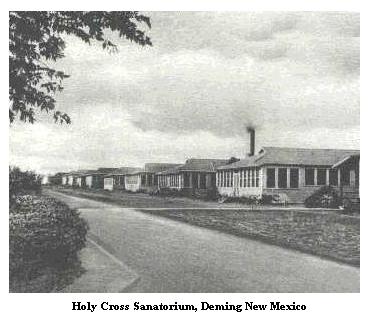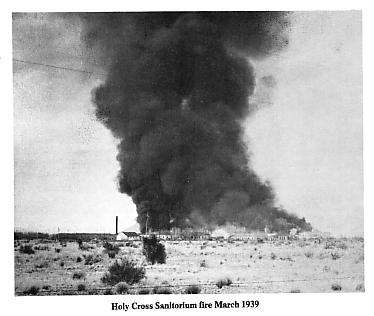History of Camp Cody
By: Unknown Author
Introduction
Unlike Fort Wingate, which was used solely as a refugee camp during World War I, Camp Cody was an active, vibrant post in southern New Mexico during the Great War. The Great War drew the military back to New Mexico in full force, if only briefly. The Army established sixteen large training centers throughout the United States for draftees and National Guard soldiers, and sixteen centers for regular Army troops. Known as Cantonments, these installations were temporary training facilities, and designed to be short-lived from their outset. The government specifically located the National Guard Training Centers in the southern parts of the U.S., because they felt that these transient soldiers were unreliable and unable to handle the harsh winter conditions of northern posts. Prominent among these new camps was Camp Cody, just outside Deming, New Mexico.
Historical Background
Since 1904, the National Guard had used the desert areas outside of Deming, New Mexico, for training, but made no improvements. Seven thousand eight hundred troops from Delaware, Arkansas, Wyoming and New Hampshire arrived in July 1916 to an open, dusty desert. These troops began permanent construction of Brigade Headquarters, a field hospital, showers, and latrines. They also set up a temporary post office and a YMCA. Nevertheless, in February 1917 for unknown reasons, the Army abruptly sent the troops home.
The Deming City Government offered the land to the federal government free of charge, if they would return and established a long-term camp in Deming. The government agreed, and made arrangements for the Southern Pacific Railroad to construct additional track in the camp area for off-loading construction supplies and later troops. J. W. Thomson of St. Louis, Missouri, received the overall construction contract. The actual building contract went to Hughs and O'Rourke Construction Company of Dallas, Texas. The government paid the contractors on a percentage formula that amounted to seven percent of the cost of construction. All told, the project cost $2,000,000 and employed 3,000 laborers.
Construction
Each cantonment throughout the United States required 8,000-12,000 acres of land, a fresh and plentiful water supply, and a railroad line. Deming qualified and with the offer of free land, barracks construction began within 60 days. Located northwest of town, Camp Cody was two and one half miles long and one and a quarter miles wide. By the close of the war, it contained three main streets and 18 cross streets, all graded and topped with gravel and soaked in crude oil. Buildings included:
120 mess houses (seating 250 men each)
Headquarters building for each regiment
Office buildings for each brigade
1200 bath houses
11 large warehouses
1 post office (capacity for 100,000 troops)
Division headquarters
5 YMCA buildings and headquarters
Regimental hospitals (12 beds each)
1 large base hospital
1 large remount station (covering 100 acres)
Troop quarters (6,000 framed and floored tents with electric lights and coal heaters)
2 large 100,000 gallon wooden water storage tank towers
Fireplugs every 450 feetThe standard building plan for the entire country was a two-story structure large enough to hold an entire company. The main floor consisted of the mess hall and kitchen, and sometimes a recreational area. The second floor was completely open with 150-200 bunks for the company. Because these barracks were of a standard design used throughout the Army and Navy, none were ever fabricated with regional styles or climate in mind. Very few even had indoor plumbing facilities. Although Camp Cody was built under Federal guidelines, it was unique that almost all the structures were one story. They were rough framed and had a low-pitched roof covered by tarpaper. These buildings served as mess halls, hospitals, headquarters, showers, and latrines. Most of the troops at Camp Cody stayed in floored tents, as the Army never did quite catch up with the influx of soldiers passing through the Camp.
The government finished basic construction of the Camp in the summer of 1917, and Camp Cody became the training center for 34th Division, (also known as the Sandstorm Division). The first contingent to arrive was the Minnesota National Guard. Over the next year and a half, more than 30,000 troops passed through the Camp. Troops from Minnesota, Iowa, Nebraska, North Dakota and South Dakota came to Camp Cody for their initial training. Instruction usually lasted but three weeks before the men traveled overseas for final training and battle.
Family Housing
Because Camp Cody was temporary, the Army did not plan or build any family housing at the post. Instead the Army and the town of Deming had a formal agreement regarding the rental management of private properties. The deal, however, did not benefit private citizens as well as they had hoped. In turn, the families who followed their men had to manage in the living conditions of a "boom" town. Officers and some enlisted rented homes and apartments in Deming, but the officers were quick to point out that the rates were excessive and a violation of the original Army agreement. A single furnished room rented for $50 per month, while a small cottage rented for $150 per month. The situation became so severe; that the camp officers threatened to build off-post quarters themselves. However, the soldiers leveled the accusations of gouging more at a group of individuals who had moved into town when the camp was built and not at the permanent residents of Deming.
In response to the growing number of complaints, the Army formed a board of officers to review all rental rates and set them according to what soldiers could pay. For example, the board estimated that an enlisted man could pay five dollars per month for an unfurnished room and seven dollars per month for a furnished room. The community protested these rates and the controversy continued until the Army left.
Codyville
Even with the town residents renting space to families, there was a shortage of housing. In anticipation of this shortage, speculators built the town of Codyville just outside the camp boundaries and northwest of Deming. These homes were poorly constructed, one bedroom cottages. Speculators also built a few apartment buildings that contained studio and one-bedroom units. Ironically, while the camp no longer exists, some of this housing is still in use today. Little more was ever written about the homes as the war ended quickly and, when it did, the Army quickly abandoned the camp. The speculators then sold the homes and apartment complexes to local businessmen and left town.
Families
As for families, only a minimal number actually followed their men to the remote desert. At the time, it was customary for an officer to remain single until he became a captain. Career enlisted men could not afford to marry, so most remained single. As for families accompanying drafted men, the Army highly discouraged the practice. The War Department attempted to defer married men with dependent families whenever possible.
The only families present at the Cantonment belonged to the camp officers with the rank of major and above and a very few enlisted men. Toward the end of the war, soldiers converted barracks buildings into apartments, but they were still incredibly primitive and temporary. All were anxiously awaiting their next assignment out of the desert or their train ticket home.
Closure
After Camp Cody closed, it quickly became a ghost town. The Army moved some of the buildings to Camp Furlong and dismantled, salvaged, or destroyed the remainder. Only the 16 buildings of the camp's main hospital were left intact. The Army used these structures for several months as a convalescent hospital for wounded hoops returning from Europe. Afterwards, Deming advertised the hospital for sale. There was only one offer. The Sisters of Notre Dame turned it into Holy Cross Hospital in 1923. The hospital operated as a sanitarium until 1939 when it closed for economic reasons. In March 1939 the sanitarium burned to the ground. Only a few pieces of foundations remain, and the memories of a few old soldiers.

|

|